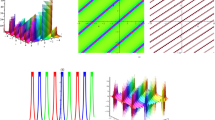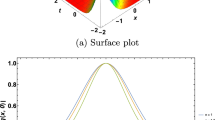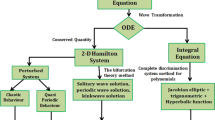Abstract
The parametric boundaries and physical mechanism of the origination of the femtosecond laser pulse splitting effect in a strongly scattering medium are ascertained on the basis of a Monte Carlo numerical solution of a nonstationary transfer equation. It is shown that the splitting effect resulting in a bimodal configuration of a pulse envelope is pronounced in a limited range of values of the scattering coefficient of the disperse medium and the anisotropy factor of the phase scattering function. The effect has been registered at pulses of less than 800 fs in length; the geometrical conditions of the signal recording are of essential importance. Under the optimal choice of parameters, the time configuration of the computed signals is in good qualitative agreement with the well-known experimental data. The accounting for the fine time structure of a transmitted signal and the multiparameter dependence of the expected effect require a certain modification of the local statistical modeling algorithms given in the Appendix.
Similar content being viewed by others
References
“Optical Tomography and Spectroscopy of Tissue VI,” Proc. SPIE. Int. Soc. Opt. Eng. 5693 (2005).
LIDAR: Range-Resolved Optical Remote Sensing of the Atmosphere, Ed. by Claus Weitkamp (Springer Sci., Business Media, Singapore, 2005).
N. Moreno, S. Bougourd, and J. Haseloff, Imaging Plant Cells, Handbook of Biological Confocal Microscopy, Ed. by J. B. Pawley (Springer Sci., New York, 2006).
A. M. Zheltikov, Supershort Pulses and Methods of Nonlinear Optics (Nauka, Moscow, 2006) [in Russian].
K. M. Yoo and R. R. Alfano, “Time-Resolved Coherent and Incoherent Components of Forward Light Scattering in Random Media,” Opt. Lett. 15(6), 320–323 (1990).
F. Liu, K. M. Yoo, and R. R. Alfano, “Ultrafast Laser-Pulse Transmission and Imaging through biological Tissue,” Appl. Opt. 32(4), 554–558 (1993).
L. Wang, P. P. Ho, G. Zhang, and R. R. Alfano, “Ballistic 2-D Imaging through Scattering Walls using an Ultrafast Optical Kerr Gate,” Science 253(8), 769–771 (1991).
A. Andreoni, M. Bondani, A. Brega, F. Paleari, and A. S. Spinelli, “Detection of Nondelayed photons in the Forward-Scattering of Picosecond Pulses,” Appl. Phys. Lett. 84, 2457–2460 (2004).
C. Calba, L. Mees, C. Rose, and T. Girasole, “Ultrashort Pulse Propagation through A Strongly Scattering Medium: Simulation and Experiments,” J. Opt. Soc. Am. A 25, 1541–1550 (2008).
V. M. Podgaetsky, S. A. Tereshchenko, A. V. Smirnov, and N. S. Vorob’hev, “Bimodal Temporal Distribution of Photons in Ultrashort Laser Pulse Passed through a Turbid Medium,” Opt. Commun, 180, 217–223 (2000).
S. A. Tereshchenko, V. M. Podgaetskii, N. S. Vorob’ev, and A. V. Smirnov, “Conditions During Passage of Short Optical Pulses Across A Strongly Scattering Media,” Kvantov. Elektron. 23(3), 265–268 (1996) [Quantum. Electron. 26, 258 (1996)]
S. A. Tereshchenko, A. V. Smirnov, V. M. Podgaetskii, and N. S. Vorob’ev, “Axial and Diffusion Models of the Laser Pulse Propagationin a Highly-Scattering Medium,” Kvantov. Elektron. 34, 541–544 (2004) [Quantum. Electron. 34, 541 (2004)].
A. Ishimaru, Wave Propagation and Scattering in Random Media, vol. 1 (Wiley, New York, 1994; Mir, Moscow, 1981).
A. Ishimary, “Diffusion of a Pulse in Densely Distributed Scatterers,” J. Opt. Soc. Am. 68, 1045–1050 (1978).
M. S. Patterson, B. Chance, and B. C. Wilson, “Time Resolved Reflectance and Transmittance for the Invasive Measurements of Tissue Optical Properties,” Appl. Opt. 28, 2331–2336 (1989).
G. M. Krekov, M. M. Krekova, and I. V. Samokhvalov, “Deformation of Short Light Pulses in Model Dispersive Media,” Izv. Vyssh. Uchebn. Zaved., Fiz., No. 5, 150–153 (1969).
E. A. Bucher, “Computer Simulation of Light Pulse Propagation for Communication through Thick Clouds,” Appl. Opt. 12(10), 2391–2400 (1973).
G. Zaccanti, “Monte Carlo Study of Light Propagation in Optically Thick Media: Point Source Case,” Appl. Opt. 30, 2031–2037 (1991).
S. L. Jacques, “Time Resolved Propagation of Ultrashort Laser Pulses Within Turbid Tissues,” Appl. Opt. 28, 2223–2229 (1989).
E. A. Sergeeva, M. Yu. Kirillin, and A. V. Priezzhev, “Propagation of a Femtosecond Pulse in a Scattering Medium: Theoretical Analysis and Numerical Simulation,” Kvant. Elektron. 36(11), 1023–1031 (2006) [Quantum. Electron. 36, 1023 (2006)].
G. A. Mikhailov, Optimization of Weighted Monte Carlo Method (Nauka, Moscow, 1987; Springer, Berlin, Heidelberg, New York, 1991).
G. M. Krekov, V. M. Orlov, and V. V. Belov, Imitation Simulation in Problems of Optical Remote Sensing (Nauka, Novosibirsk, 1988) [in Russian].
http://www.medphys.ucl.ac.uk/research/borg/homepages/davek/phd/chapter7
N. S. Vorob’ev, V. M. Podgaetskii, A. V. Smirnov, and S. A. Tereshchenko, “Observation of the Temporal Separation of Photons in an Ultrashort Laser Pulse Transmitted through a Scattering Medium,” Kvant. Elektron. 29, 181–182 (1999) [Quantum. Electron. 29, 737 (1999)].
I. S. Kutis, V. V. Sapozhnikova, R. V. Kuranov, and V. A. Kamenskii, “Study of the Morphological and Functional State of Higher Plant Tissues by Optical Coherence Microscopy and Optical Coherence Tomography,” Russ. J. Plant Physiol. 52(4), 559–564 (2005).
A. Reeves, R. L. Parson, and J. W. Hettinger, “In Vivo Three-Dimensional Imaging of Plants with Optical Coherence Microscopy,” J. Microsc. 208(3), 177–189 (2002).
J. Johanson, R. Berg, A. Pifferi, A. Svanberg, and L. O. Bjorn, “Time-Resolved Studies of Light Propagation in Crassula and Phaseolus Leaves,” Photochem. Photobiol. 69(2), 242–247 (1999).
G. M. Krekov, M. M. Krekova, and A. A. Lisenko, “Radiative Characteristics of Plant Leaf,” Opt. Atmosf. Okeana 22, 397–410 (2009) [Atmos. Ocean Opt. 22, 397–410 (2009)].
Author information
Authors and Affiliations
Additional information
Original Russian Text © G.M. Krekov, A.Yu. Kopytin, 2010, published in Optica Atmosfery i Okeana.
Rights and permissions
About this article
Cite this article
Krekov, G.M., Kopytin, A.Y. Femtosecond pulse splitting effect in the linear transfer regime. Atmos Ocean Opt 23, 188–196 (2010). https://doi.org/10.1134/S1024856010030061
Received:
Published:
Issue Date:
DOI: https://doi.org/10.1134/S1024856010030061




